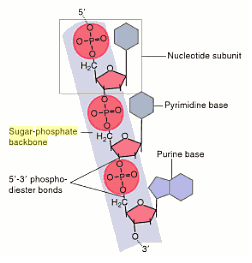Sugar phosphate backbone
The sugar phosphate backbone is an important stuctural component of DNA. It consists of 5-carbon deoxyribose sugars and phosphate groups. These sugars are linked together by a phosphodiester bond, between carbon 4 of their chain, and a CH2 group that is attached to a phosphate ion. They are extremely important in the function of DNA.

Figure 1 Diagram showing the sugar phosphate backbone of DNA, and the nitrogenous bases attached to it, forming a nucleotide [1]
Structure of DNA
DNA is wound into an right-handed double helix. This is done by the sugar phosphate backbone twisting around itself in a coil. The purpose of this twisting is to protect the bases inside it, and prevent them from being damaged by the environment. One turn of this helix is 34nm long, the diameter of it is 2nm, and there are ten bases attached per turn at 0.34nm.
Differences in RNA and DNA
RNA and DNA are both examples of phosphodiesters and have a very similar structure. However, their sugar phosphate backbone differs slightly. In DNA, the sugar involved is deoxyribose. On on the other hand, the sugar in the backbone of RNA is called ribose. These two sugars only differ by one -OH group being changed to an -H, but provides different capabilities for each molecule[2].